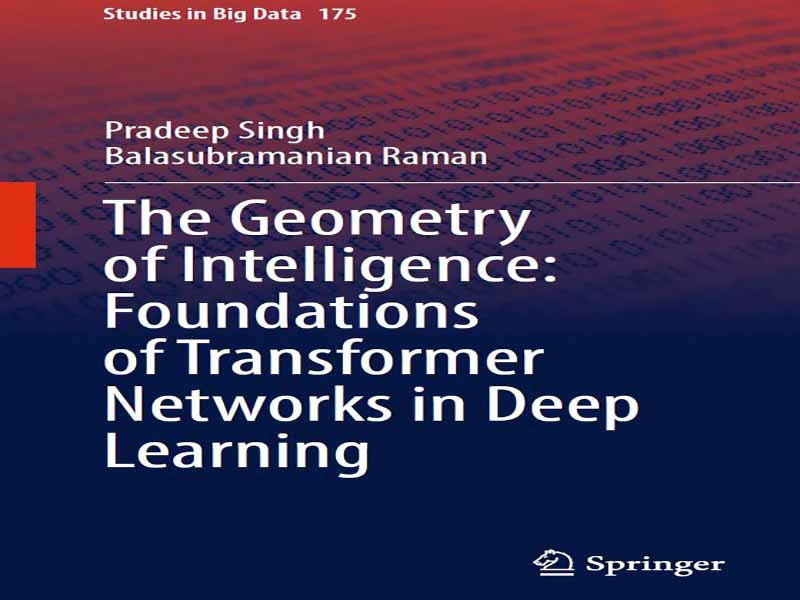- عنوان کتاب: The Geometry of Intelligence – Foundations of Transformer Networks in Deep Learning
- نویسنده: Pradeep Singh · Balasubramanian Raman
- حوزه: یادگیری عمیق
- سال انتشار: 2025
- تعداد صفحه: 375
- زبان اصلی: انگلیسی
- نوع فایل: pdf
- حجم فایل: 2.49 مگابایت
مطالعهی ترانسفورماتورها، بهویژه در زمینهی پردازش زبان طبیعی و یادگیری ماشین، انقلابی در نحوهی درک و پردازش دادهها ایجاد کرده است. موضوع اصلی این انقلاب، مفهوم بازنمایی است: اینکه چگونه دادهها، چه کلمات در یک جمله، چه پیکسلها در یک تصویر یا گرهها در یک گراف، به یک ساختار ریاضی تبدیل میشوند که یک ماشین میتواند آن را دستکاری کند. درک این فرآیند از دیدگاه ریاضی، مستلزم آن است که ما در نظریهی فضاهای برداری و جبر خطی، که ستون فقرات نظریهی بازنمایی را تشکیل میدهند، کاوش کنیم. در مدلهای ترانسفورماتور، دادهها به صورت بردارهایی در فضاهای با ابعاد بالا نمایش داده میشوند. این بردارها نه تنها ویژگیهای ذاتی دادهها، بلکه روابط و تعاملات بین نقاط دادهی مختلف را نیز ثبت میکنند. عملیات انجام شده روی این بردارها، مانند مکانیسمهای توجه و تبدیلهای خطی، به شدت به اصول فضاهای برداری متکی هستند. بنابراین، درک عمیق فضاهای برداری، زیرفضاها و پایهها برای درک چگونگی رمزگذاری و دستکاری اطلاعات توسط ترانسفورماتورها ضروری است. علاوه بر این، ترانسفورماتورها از مفهوم تقارن – اصلی که عمیقاً ریشه در نظریه گروهها و نظریهی بازنمایی دارد – بهره میبرند. تقارن به ما این امکان را میدهد که بفهمیم چگونه تبدیلهای خاص، مانند چرخش یا انتقال، بر نمایش دادهها تأثیر میگذارند. با بررسی این تقارنها در چارچوب فضاهای برداری، میتوانیم به بینشهایی در مورد تغییرناپذیریها و همواریانسهایی که مدلهای ترانسفورماتور را بسیار قدرتمند میکنند، دست یابیم. این فصل به عنوان پایهای برای چارچوب ریاضی زیربنای ترانسفورماتورها عمل میکند. ما با معرفی مفاهیم اساسی فضاهای برداری و جبر خطی شروع میکنیم. این مفاهیم نه تنها ابزارهای لازم برای تجزیه و تحلیل و درک مدلهای ترانسفورماتور را فراهم میکنند، بلکه ارتباطات عمیق بین هندسه، تقارن و هوش را نیز آشکار میکنند. با پیشرفت، خواهیم دید که چگونه مفاهیم ریاضی انتزاعی معرفی شده در اینجا در عملیات عملی ترانسفورماتورها آشکار میشوند و زمینه را برای مباحث پیشرفتهتر در فصلهای بعدی فراهم میکنند. از طریق کاوش ریاضی، هدف ما ایجاد شهودی برای نحوه عملکرد ترانسفورماتورها است که مبتنی بر زبان دقیق فضاهای برداری و تبدیلهای آنها باشد. این امر ما را قادر میسازد تا از دیدگاه صرفاً ریاضی، ظرافت و قدرت ترانسفورماتورها را درک کنیم، جایی که تمرکز بر پیادهسازی یا کد نیست، بلکه بر ساختارهای ریاضی اساسی است که این مدلها را هدایت میکنند.
The study of transformers, particularly in the context of natural language processing and machine learning, has revolutionized the way we understand and process data. The central theme of this revolution is the concept of representation: how data, whether it be words in a sentence, pixels in an image, or nodes in a graph, is transformed into a mathematical structure that a machine can manipulate. Understanding this process from a mathematical perspective requires us to delve into the theory of vector spaces and linear algebra, which form the backbone of representation theory. In transformer models, data is represented as vectors in high-dimensional spaces. These vectors capture not only the intrinsic properties of the data but also the relationships and interactions between different data points. The operations performed on these vectors, such as attention mechanisms and linear transformations, rely heavily on the principles of vector spaces. Therefore, a deep understanding of vector spaces, subspaces, and bases is essential for comprehending how transformers encode and manipulate information. Moreover, transformers leverage the concept of symmetry— a principle deeply rooted in group theory and representation theory. Symmetry allows us to understand how certain transformations, such as rotations or translations, affect the data representations. By exploring these symmetries within the framework of vector spaces, we can gain insights into the invariances and equivariances that make transformer models so powerful. This chapter serves as a foundation for the mathematical framework that underpins transformers. We begin by introducing the fundamental concepts of vector spaces and linear algebra. These concepts will not only provide the necessary tools to analyze and understand transformer models but will also reveal the deep connections between geometry, symmetry, and intelligence. As we progress, we will see how the abstract mathematical notions introduced here manifest in the practical operations of transformers, setting the stage for more advanced topics in later chapters. Through mathematical exploration, we aim to build an intuition for how transformers operate, grounded in the precise language of vector spaces and their transformations. This will enable us to appreciate the elegance and power of transformers from a purely mathematical standpoint, where the focus is not on implementation or code, but on the underlying mathematical structures that drive these models.
این کتاب را میتوانید از لینک زیر بصورت رایگان دانلود کنید:
Download: The Geometry of Intelligence




































نظرات کاربران